Artist based in Queens, NY
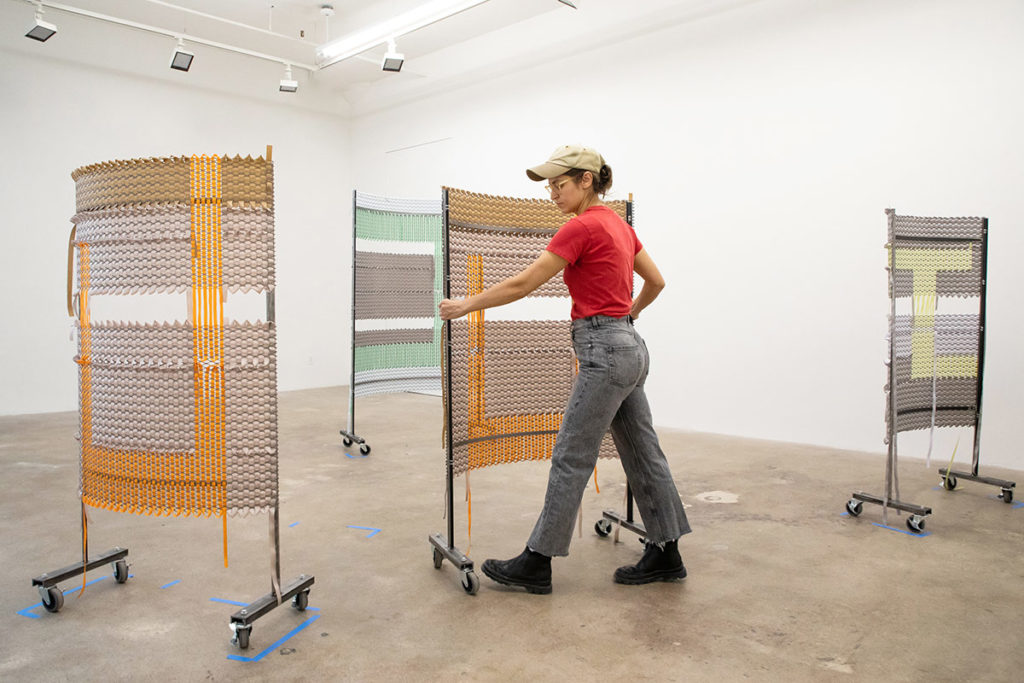
Alina Tenser, Portrait of the artist
Parentheses, activated by the artist at HESSE FLATOW, 2022. Photo courtesy of HESSE FLATOW.
Tell us about yourself, what's your background?
I was born in Soviet Ukraine in the capital city Kyiv and moved to the States with my family when I was 9. At a very young age, maybe 4 or 5 I announced that I wanted to be a claymation artist (there was a bunch of great claymation and animation during the soviet era) and I think at that time what I meant is that I wanted to be an artist that worked with materials and claymation was what I understood that to be. What's funny is that materiality, movement, and play are at the core of my practice today. I do not have other family in the visual arts however my brother is a writer and linguist and both of us agree that the most formative experience that we continue to mine and come back to in our work is the somewhat convoluted immigration (we relocated from Kyiv to a temporary settlement in Austria and then Italy before touching down in Baltimore) as well as the immigrant experience once we settled here.
Going back to movement and play, I started graduate school when my son was just under a year old. My professional practice really developed in conjunction with caring for my son and observing early childhood development. The various transformation of childhood and the tethered relationship of childhood and parenthood are present in my work.
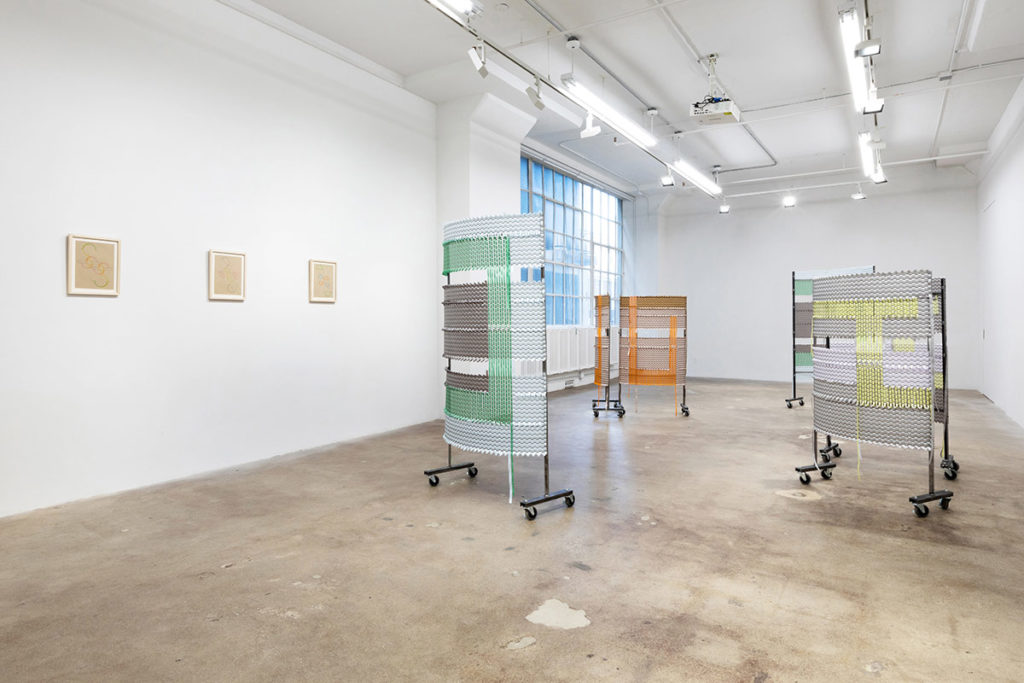
Particular Kind of Embrace installation view of exhibition at Hesse Flatow, 2022, dimensions variable. Descriptive Information: February-March of 2022 I presented a solo exhibition at Hesse Flatow Gallery, New York, NY that consisted of 2 bodies of work - Parentheses and Containers for Utterances. Featured here is the installation of Parentheses sculptures. Photo courtesy of HESSE FLATOW.
In a sense both, the immigrant experience and the years of early motherhood and single motherhood, both lend themselves to a sort of resourcefulness. I love that word: resourcefulness. For me it’s a creative force that exists in a circumstance of lack- there has to be a lack of resource for resourcefulness to get activated.

Container For Utterance ДЯДЯ, 2022. Vinyl, zipper, steel rods, concrete, dimensions variable. Descriptive Information: The series consists of cast concrete Cyrillic letterforms encased in transparent vinyl stitched together with a single long zipper. These are visual manifestations compartmentalizing my first language (Russian/ Ukrainian) while learning English, and the semantic slippages, mistakes and hiccups I encountered on the way. Photo courtesy of HESSE FLATOW.
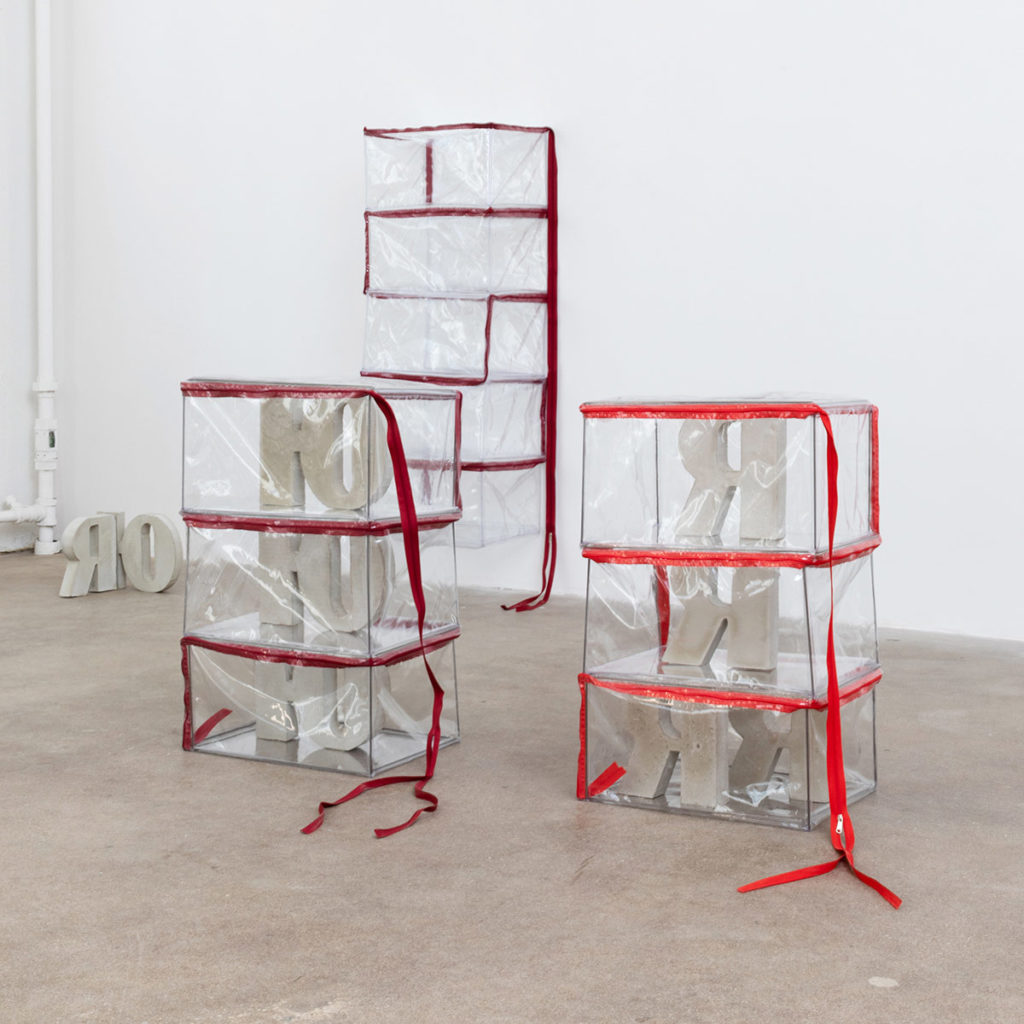
Container For Utterance, ЯЮ, 2022. Vinyl, zipper, steel rods, concrete, dimensions variable. Descriptive Information: Some pieces from this series added up to words, others phonetic utterances. ЯЮ does not translate to be a word but reflects on the phonetics relationships that occur across languages. Я is a vowel that means “I” in Russian, while Ю has no meaning but sounds like the English “you”. Photo courtesy of HESSE FLATOW.
"I was born in Soviet Ukraine in the capital city Kyiv and moved to the States with my family when I was 9. At a very young age...I announced that I wanted to be a claymation artist (there was a bunch of great claymation and animation during the soviet era)...What's funny is that materiality, movement, and play are at the core of my practice today."
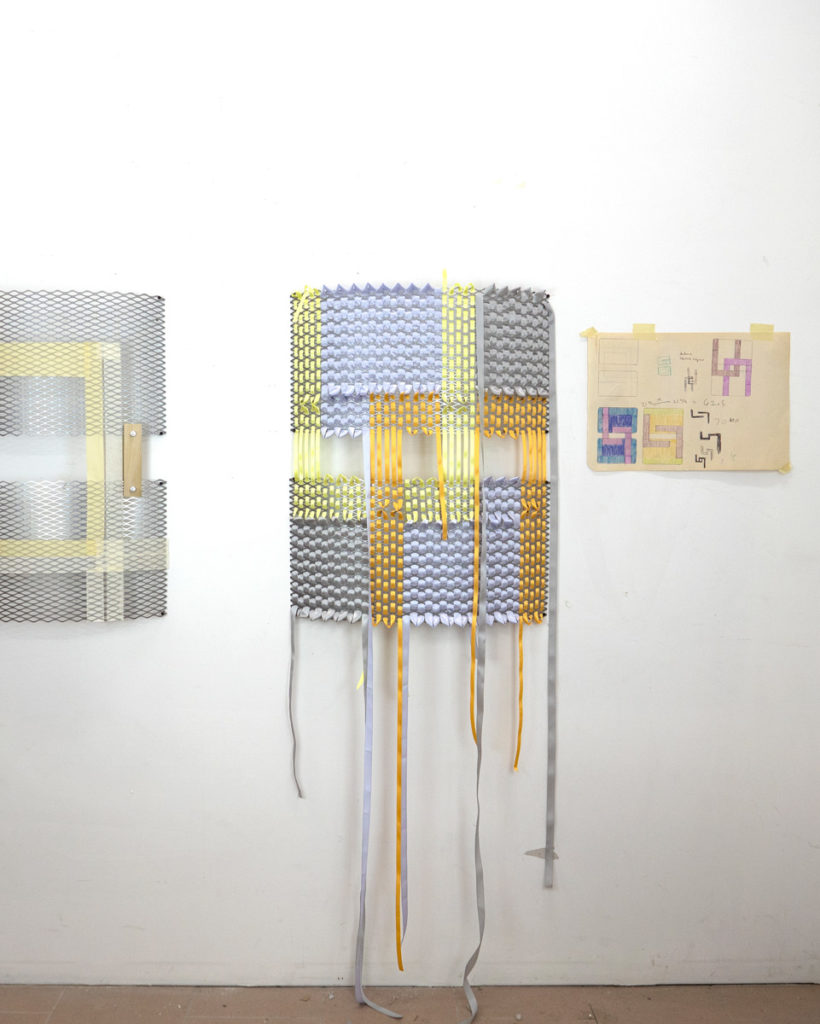
WIP “Meanders” (rolled expanded metal, satin ribbon) in my studio in Maspeth, Queens, 2022

WIP “Meanders” (rolled expanded metal, satin ribbon) in my studio in Maspeth, Queens, 2022
What are you currently working on and where did the inspiration for it come from?
I recently completed two large bodies of work that I exhibited at HESS FLATOW. They were part of a solo show called "A Particular Kind of Embrace". I often work in a "geminiacal" way, having at least two bodies of work germinating simultaneously. They are often materially very different from each other but I am convinced that they somehow belong together. That was the case for these works. "Parentheses" series is made out of expanded metal and satin ribbon. The pieces are set on casters and immediately call for movement and performance, which I actually held back from during the the run of the exhibition but would like to develop in collaboration with a choreographer in a more performance oriented context. The Other body of work was "Containers for Utterances" which are vinyl multi-tiered structures that are held together with continuous zippers- some up to 10 yards (30 feet!) long. They were a brain twister to make. Inside the containers are Cyrillic letters- some adding up to words and others existing as phonetic utters. I know the majority of my audience is not able to read the letters and engages with them through the process of recognition and othering because of the overlaps and divergences in Roman and Cyrillic letterforms. I am satisfied with that read. However each of the sculptures also has a more in-depth read that requires the knowledge or translation of the language.
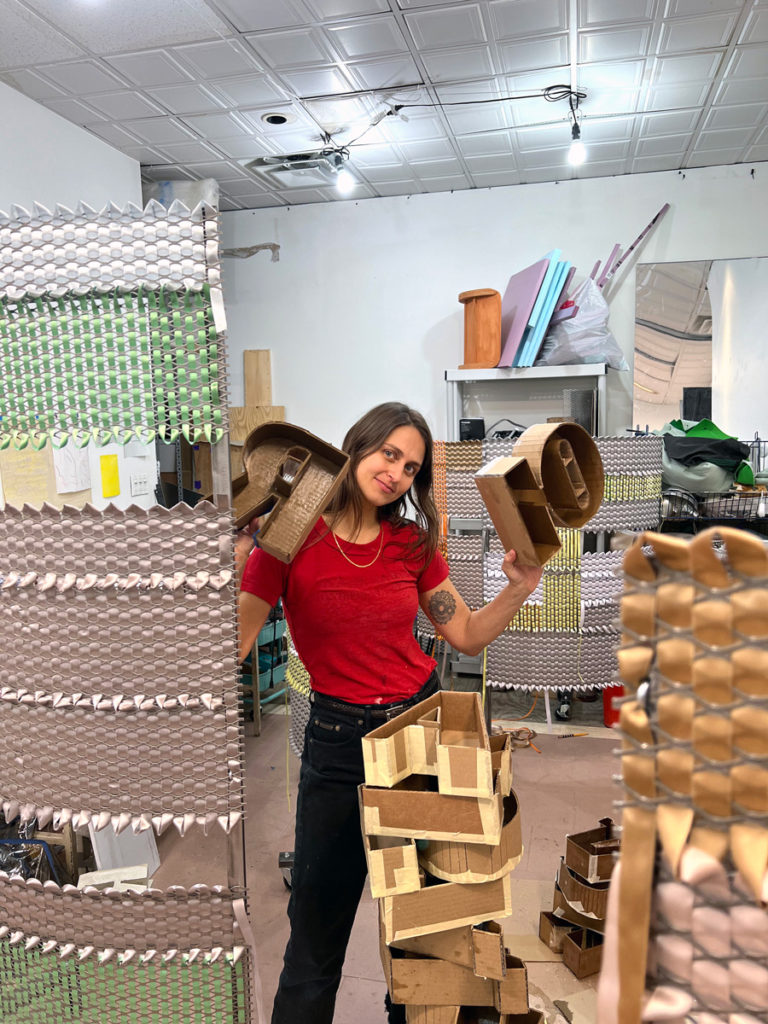
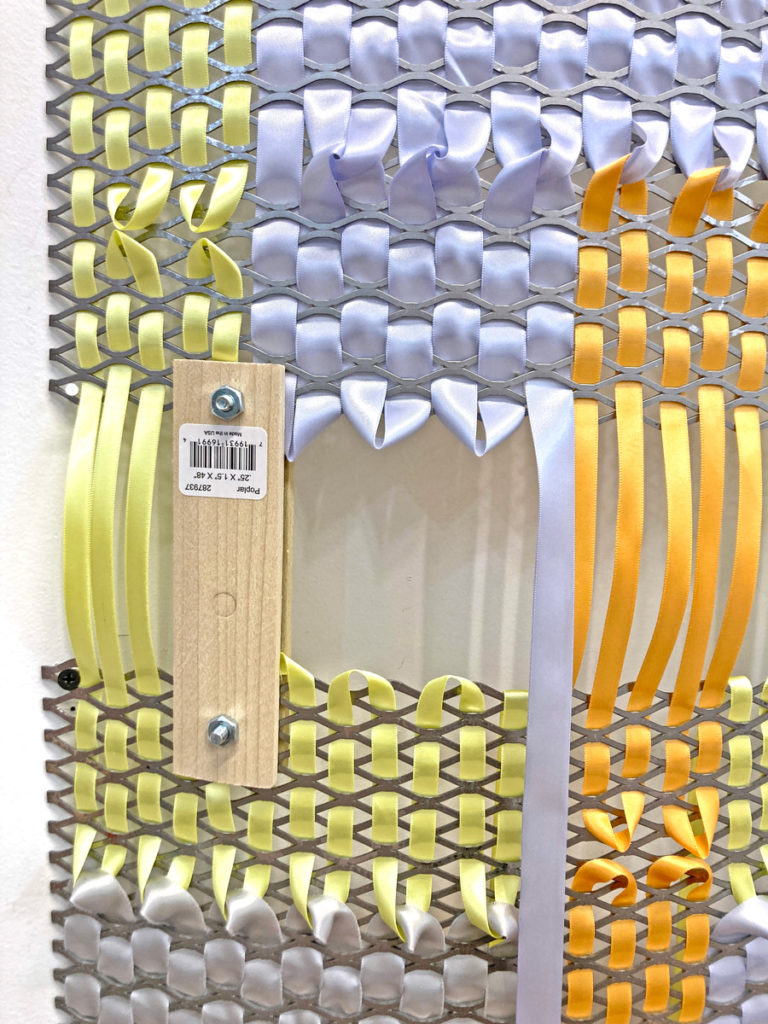
I am currently continuing on the thread that I started with both of these bodies of work in preparation for a solo exhibition at SE Cooper Contemporary in Portland, OR. I am excited about how weird this new work is getting and not quite ready to apply words to it! But please stay tuned to news about the show and the work in March 2023.
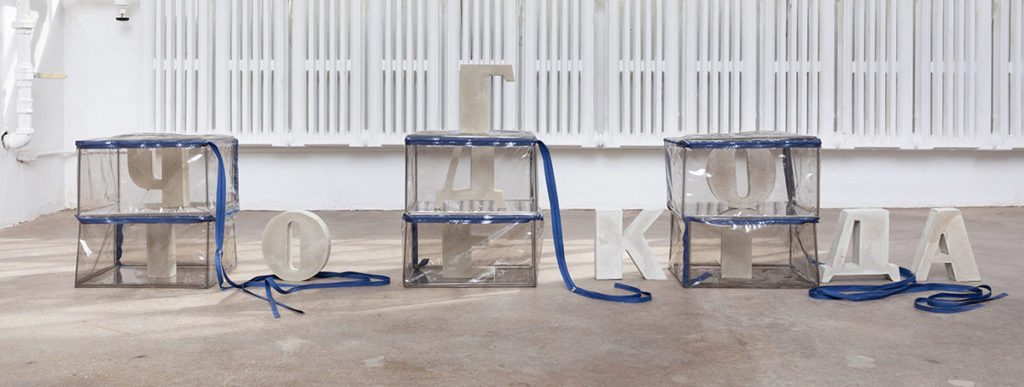
Container For Utterance ЧТО ГДЕ КОГДА, 2022. Vinyl, zipper, steel rods, concrete, dimensions variable. Descriptive Information: ЧТО ГДЕ КОГДА Translates to “What, Where, When” and is the name of the only Soviet game show. The premise of the show was that citizens from across the USSR sent in trivia questions and contestants would answer them. However it is doubtful that the questions posed by citizens were ever really asked. Photo courtesy of HESSE FLATOW.
Innovation does not only happen in the field of technology — it occurs everyday in a creative practice. What do you do for inspiration?
I often work with domestic as well as industrial materials and processes. Using manufactured products like zippers, ribbon, trackpads, paint-rollers. I like the idea of using them out of context or over-extending them in some way. This goes back to the idea of resourcefulness and my personal formative experiences of being an immigrant—of cultural and linguistic observing, misunderstanding, reinterpreting—and the experience of observing a young child take the world in. These products intended for narrow and rigid purposes open up to all kinds of possibilities. For me, there’s a really cool agency and innovation in that. I feel the same way about developing my own “craft”. Working within the haptic, repetitive, lexicon of craft but not within a specific tradition. I mean, that’s how any traditional craft came to be. I enjoy that type of labor but like the puzzle of figuring it out outside of a traditional beholding.
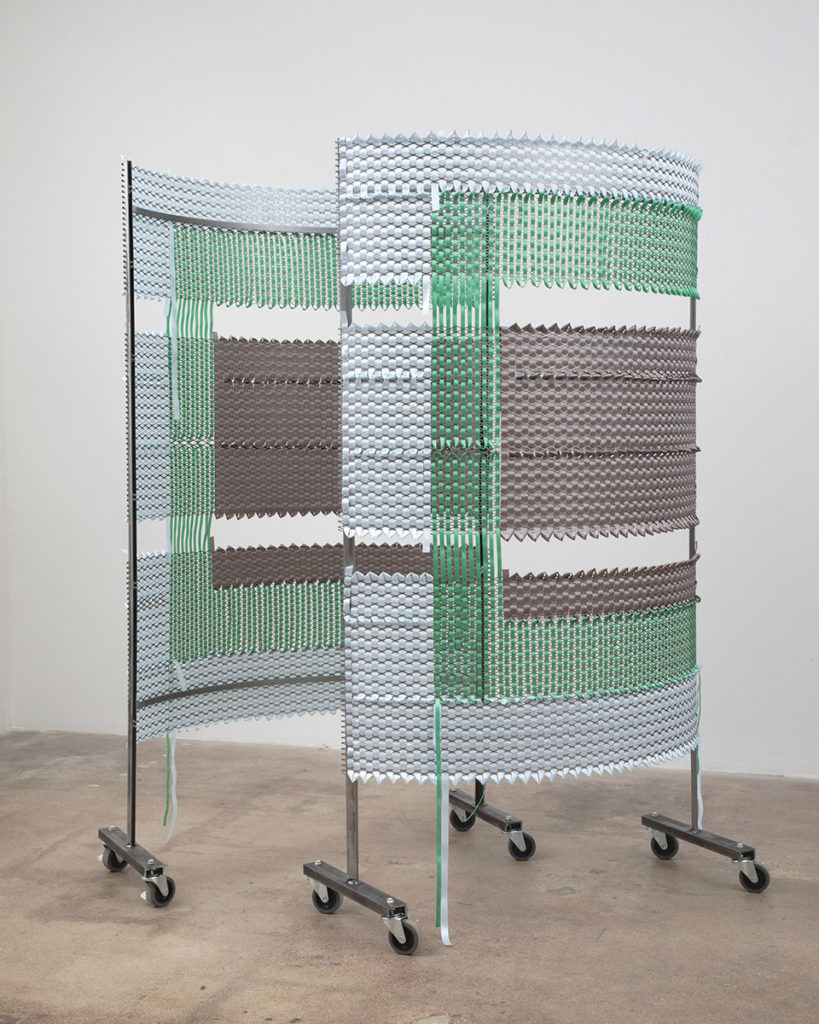
Parentheses, Green Path, 2022. Satin ribbon, steel, expanded metal, casters. 72" x 41" x 16" . Photo courtesy of HESSE FLATOW.
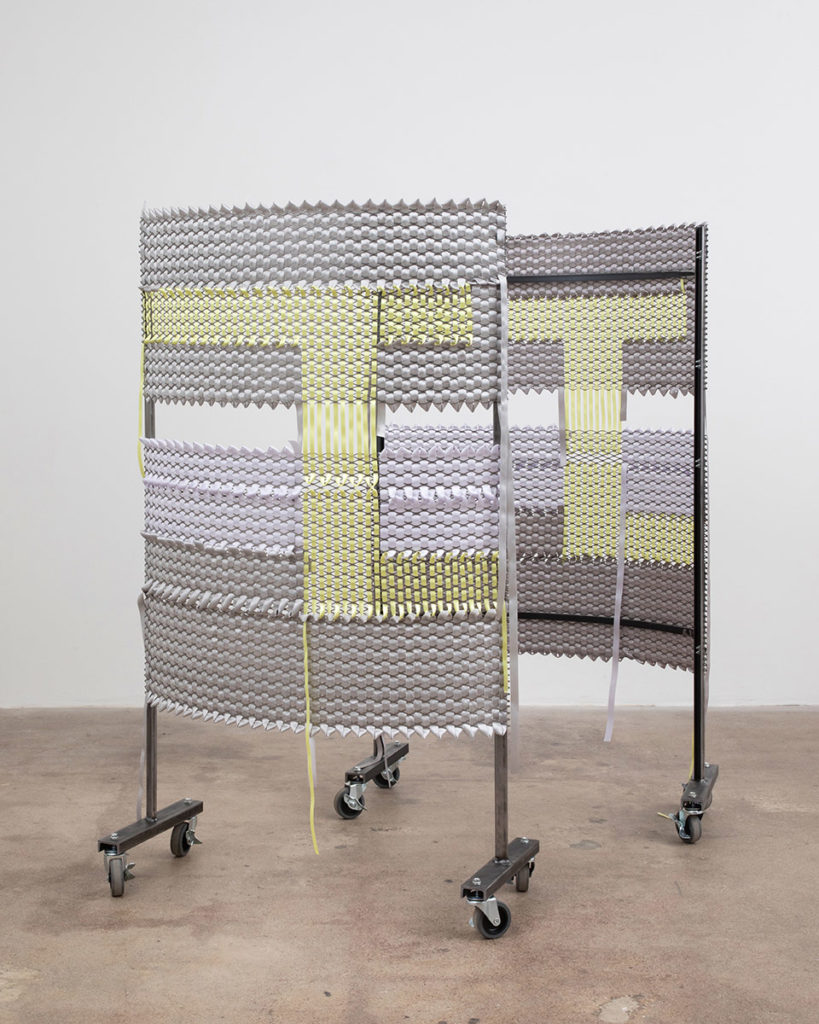
Parentheses, Yellow Path, 2022. Satin ribbon, steel, expanded metal, casters. 57” x 33” x 14”.
Descriptive Information: When making the Parentheses, I developed a surface that was simultaneously soft and hard by enmeshing satin ribbon and expanded metal. The design on the face of these Parentheses is informed by geometric ornaments that often preceded written letterforms. Photo courtesy of HESSE FLATOW.
Describe your practice and process. Where do ideas start for you? In the studio or being in the world?
Most of the time my process starts with mucking around with materials that are catching my interest at the time. Sometimes it's purely haptic and tactile, sometimes it will be something specific like the etymology of the name of the material… that's how I starting working with marble. I was playing around with my sons play marbles and started thinking about their possible relationship to the composite stone, I looked up the etymology and a body of work developed from there.
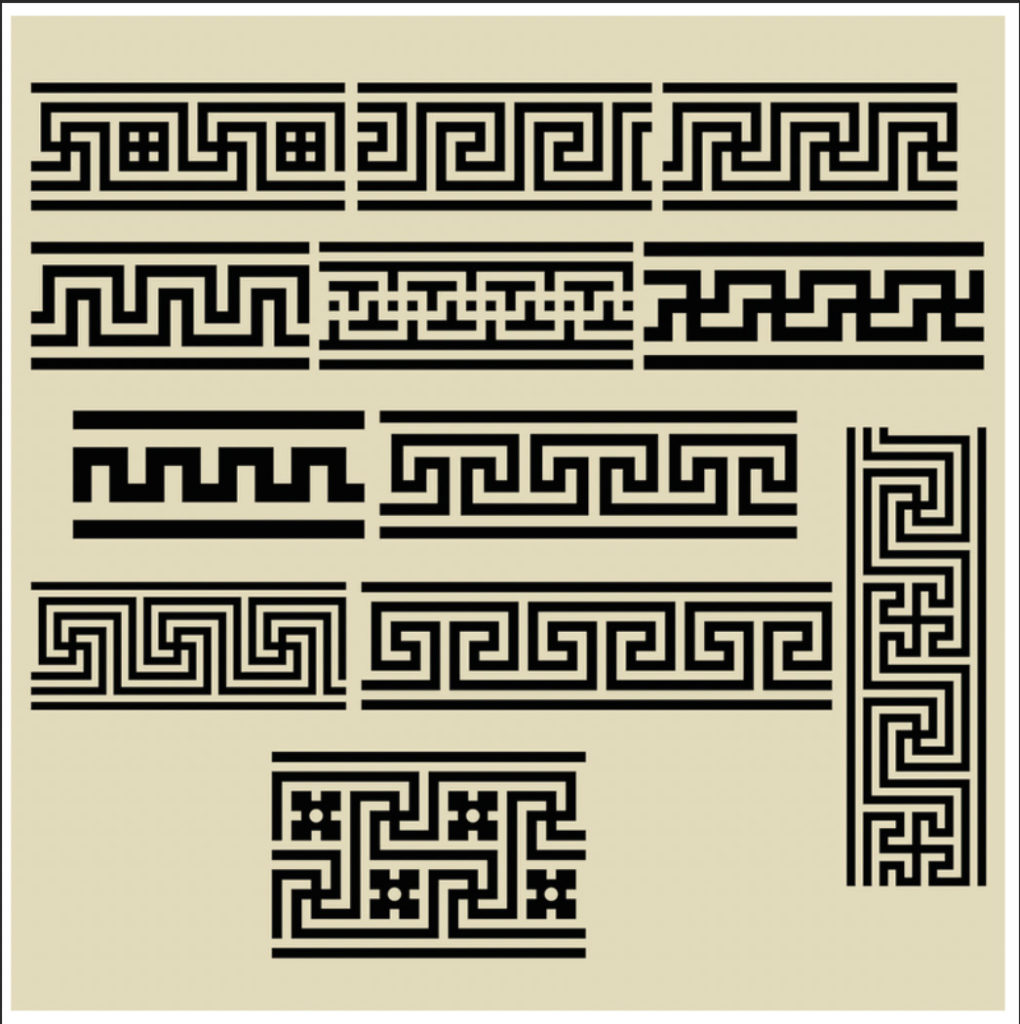
Different types of Ancient Greek Meander ornaments
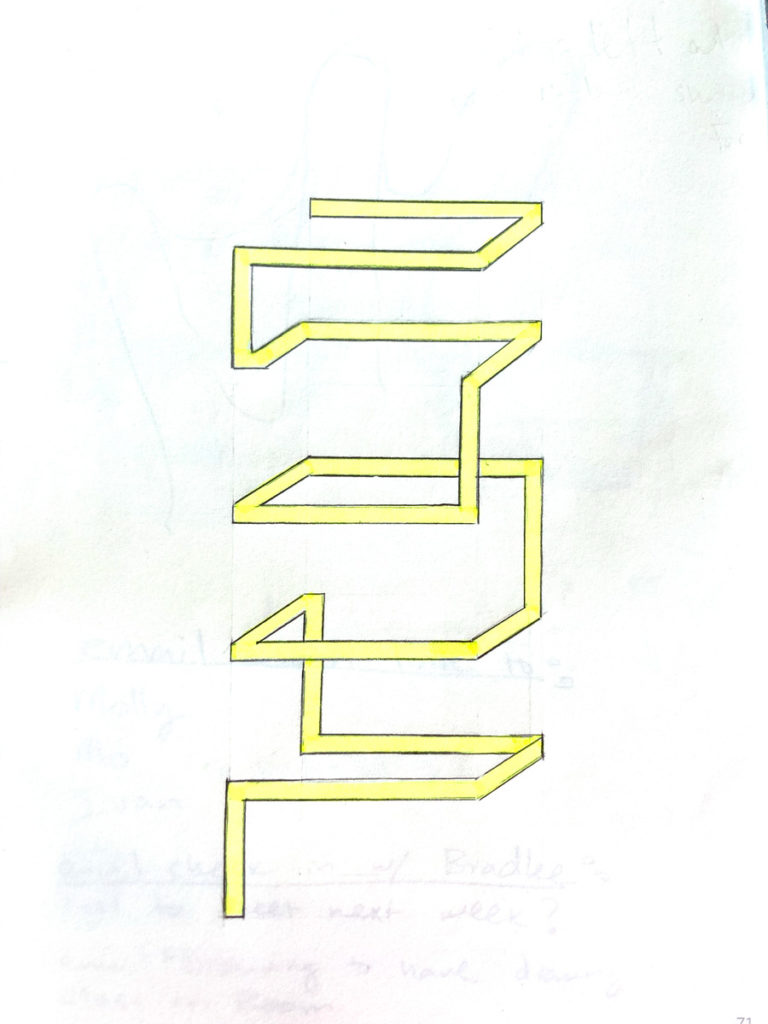
Drawing for winding zipper path for “Containers for Utterance”, 2021
So it really happens between my home life and the studio. I often follow inspiration and curiosity about creating a specific type of surface before I have ideas regarding form. This isn’t always the case, but I tend to be smarter and more confident when it comes to surfaces. I love acquiring new skills and I often find that with new bodies of work I end up having to learn them for example stone carving, machining, sewing. As an artist I have never had a medium or material that I stuck with but I love expanding my making vocabulary.
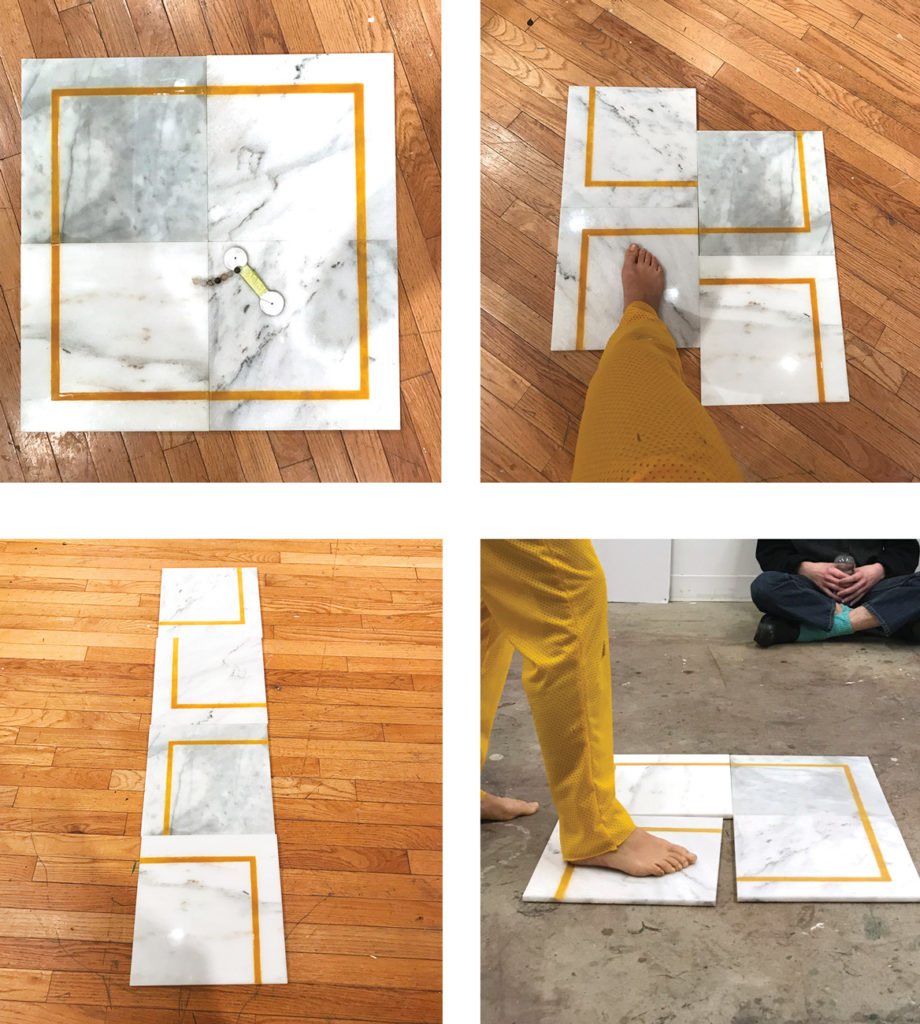
Constructing paths/ meanders with rubber-inlaid marble tiles at Queens Museum (Queens Museum Studio Program Residency). 2018
I am also a big fan of artist residencies for the uninterrupted time they provide and community building; very energizing! As a single parent residencies are often not available to me, sometimes due to the academic schedule, or because they are not "family friendly", or they claim “family friendly” with an expectation that a partner will join and do childcare (which marginalizes many artists, especially single parents who are majority women). However I can say that I’ve done a couple of residencies that have been skill specific like Vermont Sculpture and Carving Studio and Sculpture Center which felt very fortifying. I love the uninterrupted pace that residencies can provide and have really appreciated places like Interlude Artist Residency which provide all kinds of support for parent artists to have the gift of that focused studio time.
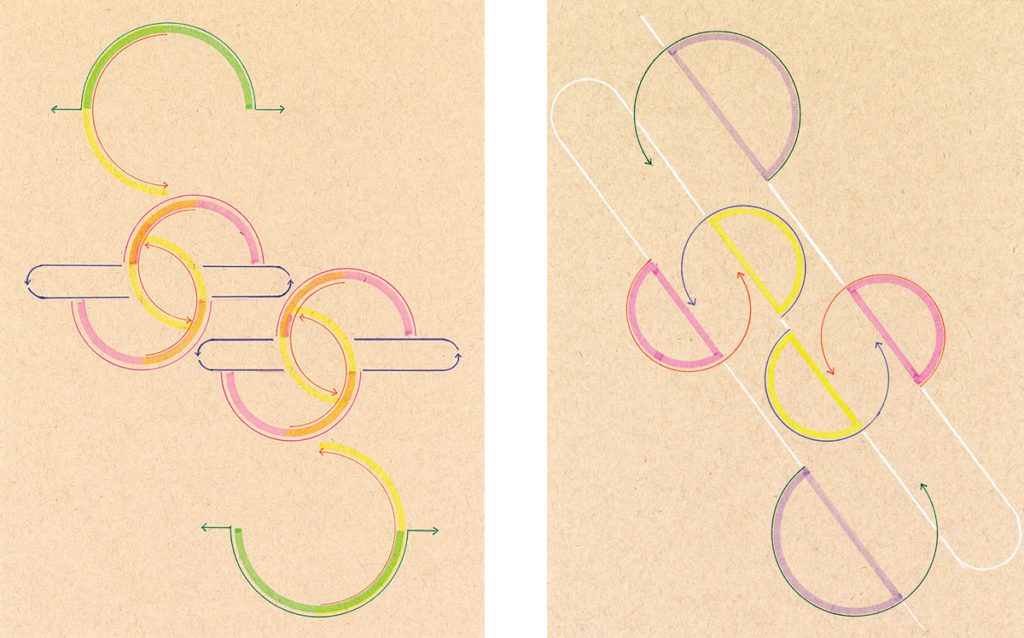
Potential Choreographies 4 and 8, 2021. Pencil, highlighter, and marker on toned paper. 12” x 9” each. Descriptive Information: Potential Choreographies are notation drawings for the Parentheses and were exhibited in the same space. The drawings help envision possible spacial orientations and movements of the Parentheses. Photo courtesy of HESSE FLATOW.
How do you make your work, does it start with a sketch?
My work rarely starts with a sketch, but rather some material play, often combining unlikely materials and objects together, playing around with their movement to understand a potential and where I fit in as a maker-performer. I am not sure what my style is- it has been described to me as fitting within a post-conceptualist tradition, I often use minimalist forms like cubes and cylinders but I always undermine their autonomy by having a very relatable, everyday element. They are connected to the real world, the home, the store, the felt space. The aesthetics of my work are a combination of making and buying, I'm often caught shopping for an object that strikes the correct tenor with the rest of the object. I often don't even know what I'm looking for until I see it and touch it. I'm sure somewhere in there there's an underlying desire for commodity and packaging that I was only exposed to after leaving Kyiv. I recall early interactions with simple things like yogurt packaging and toy packaging so deliberately desireful that it outshined the toy.

Casting concrete Cyrillic letter-forms in my studio, Maspeth, Queens, 2022
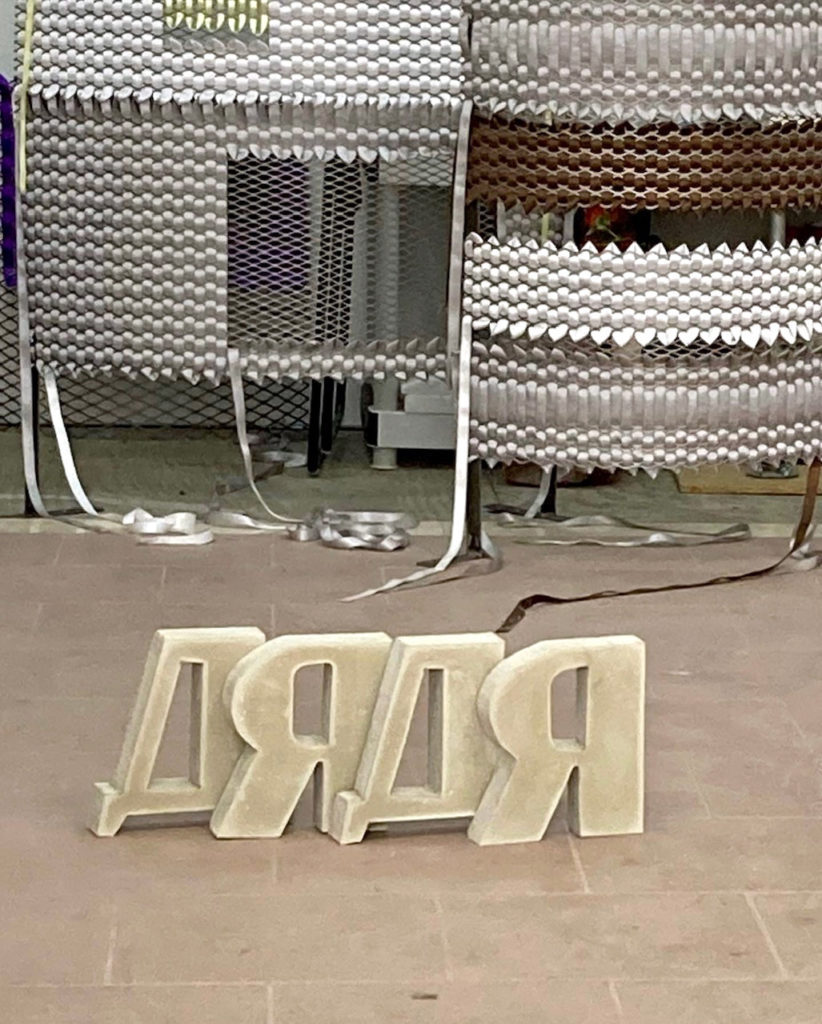
Cast concrete Cyrillic letter-forms in front of small models for “Parentheses”

Unzipping a long “Container for Utterance” made out of tinted Vinyl and over 10 yards of continuous zipper. Photographed behind my studio in Maspeth, Queens by Gustavo Murillo, 2021
Who are your biggest influences?
An early inspiration was Ree Morton. Her work and her biography were both important to me. Early on it good to identify artists that “give you permission”, and she was that for me. In a recent exhibition of hers I remember seeing a grant application she wrote to the Pollock-Krasner Foundation (if I’m not mistaken..) and in it she spoke candidly about child care, financial hardship and her love and dedication to her practice. Another influence is Morton’s contemporary and friend Rosemary Mayer, who’s work my good friend and artist, Amanda Friedman, introduced to me. Her meticulous ways of connecting and thinking through complex physical installation through drawings is something I glean from. Lygia Clark and Charlotte Posenenske are the two artists that my current work most deeply connects to. I love Clark's later work, "Body Fantasy Dimensions," that segued her practice into somatic therapist. Artist Fawn Kreiger and I are working on a collaboration building off of Clark’s “Body Fantasy Dimensions”.
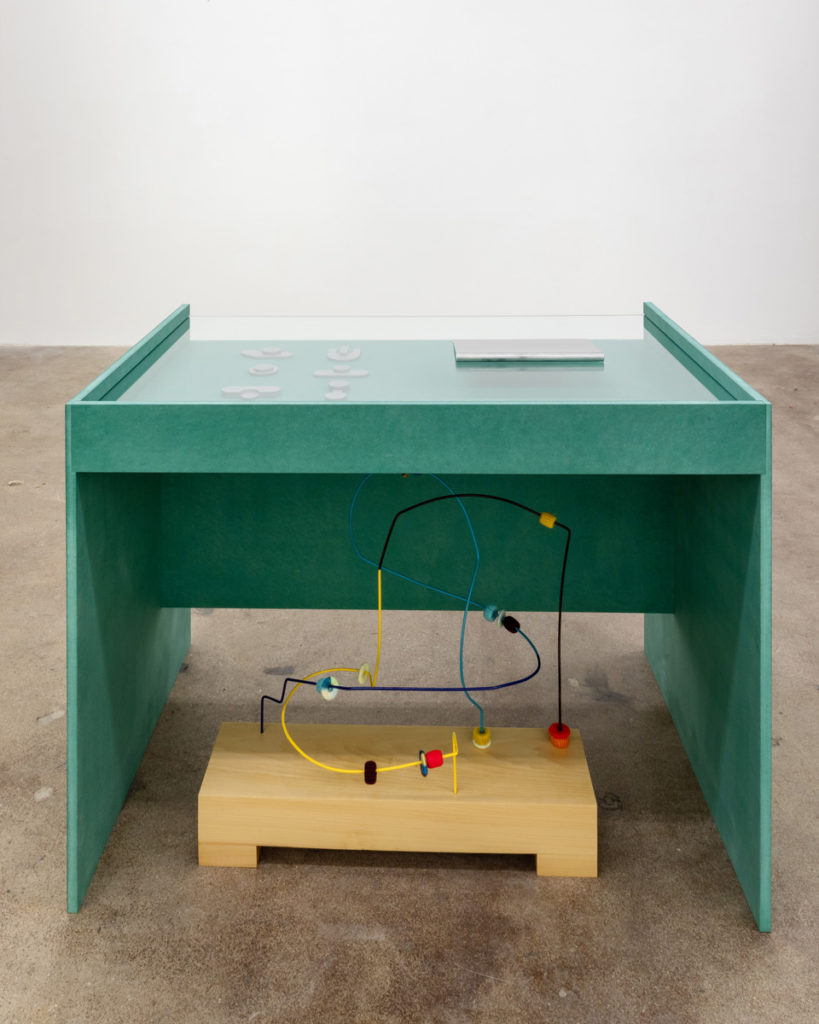
Wrk Frm Home, 2020. Dyed MDF, aluminum, glass, steel rod, wood, paint, hardware, yarn 36” x 47” x 31”. Descriptive Information: In this piece 2 separate environments are established within a single object- a work desk. There is the “work station” area on top and a sculpture that resembles children’s bead puzzles under the desk. On top of the “work station is a form that looks like a track pad and just underneath the glass are aluminum based on trackpad hand gestures patented by Apple. The bead puzzle is also based on captured gestures of my unconscious hand movements observed on a recording of teaching on zoom. Photo courtesy of HESSE FLATOW.
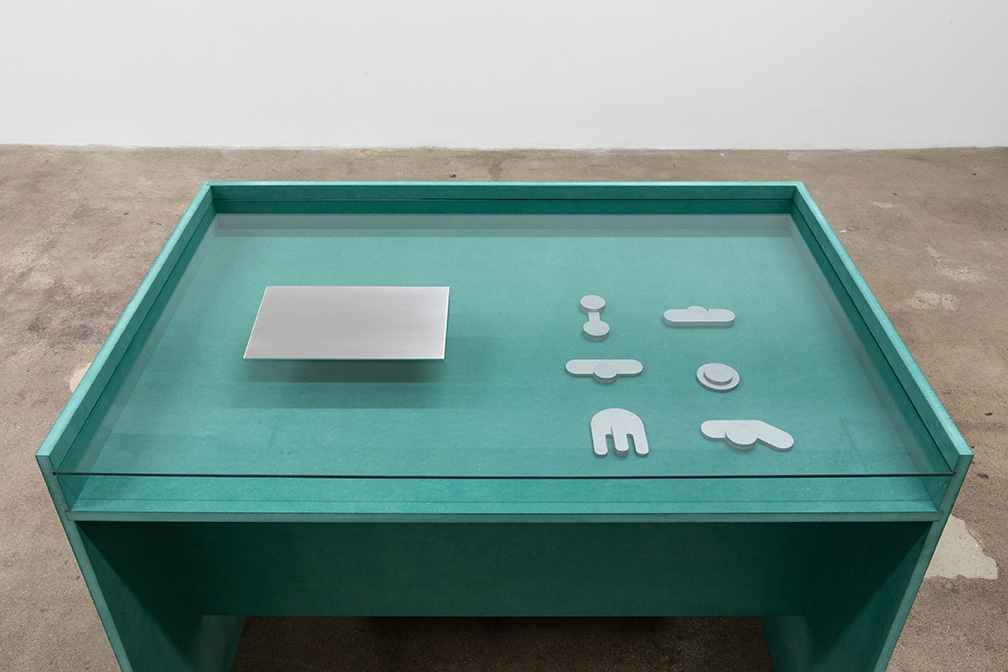
Wrk Frm Home, detail view, 2020. Dyed MDF, aluminum, glass, steel rod, wood, paint, hardware, yarn, 36” x 47” x 31”. Photo courtesy of HESSE FLATOW.
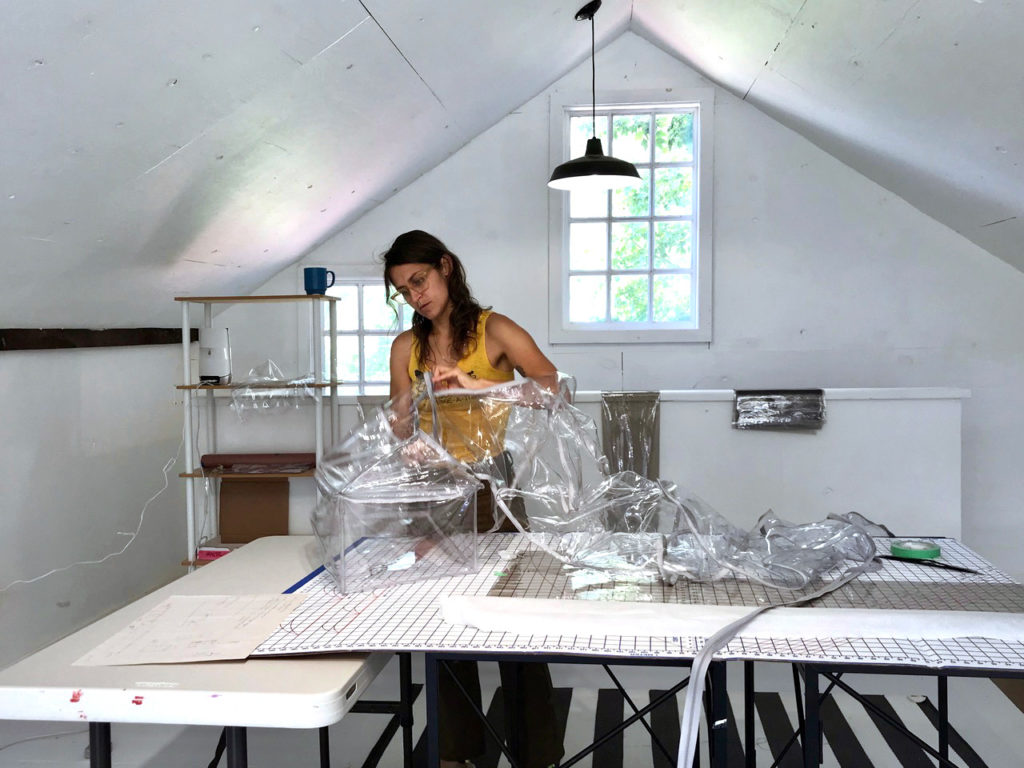
Alina Tenser, Portrait of the artist
What’s the best piece of advice you’ve been given?
Do not give everything all at once When talking or writing bout your work. This advice was given to me in graduate school by my thesis reader at VCU, Ester Partegàs. This was in reference to writing about my work and feeling anxious about needing to account for everything in my practice. She reassured me that I don’t need to give it all away. Some things I can give at another time, and some I can keep just for myself. This advice is applicable to selecting work for a show, or giving an interview or artist talk.
What is the best advice you would give to other artists?
There are many emotional ups and downs in this line of work. When the downs strike have go to’s that connect you to something larger than personal dejection. Sometimes it’s going out to see work that affirms you as an artist and connects you to community outside of your practice, other times it’s stepping out of art all together and going on a hike to get grounded in nature, sometimes it’s allowing yourself to experiment and make what I like to call “not my work” for a bit- something that lets the ego rest and curiosity to tingle.
Stay up to date with Alina Tenser
Instagram @alina_tenser
alinatenser.com
hesseflatow.com/artists/48-alina-tenser